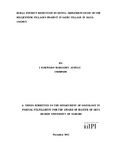| dc.description.abstract | The Millennium villages Project (MVP) is an organization whose broad mandate is to alleviate rural based on the Millennium Development Goals. To alleviate poverty in Sauri village the MVP developed an agricultural strategy in order to increase productivity. Farmers were provided farmers with improved seeds, fertilizers, horticultural seedlings, well as agricultural extension services. The MVP also invested in the following sectors; health, education, roads, markets, energy, water, sanitation and environment.
This study sought to discover if the MVP agricultural interventions had alleviated poverty in Sauri village. The objectives of the study were: a) To review how the MVP agricultural strategy has been conceptualized and implemented to alleviate poverty in Sauri village, b) To examine how the local people have been engaged in the conceptualization and implementation of the MVP and how they perceive the project, c) To establish the extent to which the MVP has contributed in reducing poverty among the local people in Sauri village and d) To establish the appropriateness of the MVP agricultural strategy in Kenya and its sustainability.
This study attempted an experimental design in survey research. Sauri village was the experimental group and Lundha village was used as the control group. This was to enable the researcher to assess the impact of the MVP interventions on poverty in Sauri village. The researcher collected quantitative data from respondents by administering questionnaires using structured interviews. The probability sampling methods that were used in this study were cluster sampling and simple random sampling.
The total sample size of both these villages was 243. That is, 142 and 101 households in Sauri and Lundha village respectively. Qualitative data was collected through unstructured interviews with Key Informants as well as in Focus Group discussions. An interview guide was used to keep the interview in line with the research objectives. Non-probability sampling technique that was used to select Key Informants in this study was purposive sampling. Non-participant observation was also used by the researcher to collect observational data. This was done using an observation checklist. The raw data was processed using Statistical Package for Social Sciences (SPSS).
Descriptive statistics were used to univariate data. Findings from the study revealed that Sauri community was not actively involved in problem identification, monitoring and evaluation of the MVP agricultural interventions. However, the community mostly participated in the implementation 'of the MVP activities. The MVP achieved its goal of increasing agricultural productivity (95%) and alleviating poverty (94%) in Sauri village. Respondents reported the leading key achievements of the MVP as improving access to health care, improvement of roads, increased agricultural productivity and improvement of education sector. This indicates that besides improving agricultural productivity, the MVP promoted access to basic services. However, the MVP was not successful in promoting access to electricity in the village (83%). This indicates that Sauri farmers cannot engage in value addition for their produce which is crucial to increasing farmers' incomes.
Study findings revealed that the MVP promoted gender balance in Sauri village (70%). Women were elected to leadership positions in various committees and were allowed to participate in all MVP activities indiscriminately. According to 97% of .respondents, the MVP was a suitable model for promoting agriculture in Sauri village. Note that, 60% of respondents reported that the MVP was not sustainable due to corruption among the MVP leaders, lack of people's participation, poor phasing out, lack of capacity building and farm inputs. This study advocates for full participation of target communities in the following stages of the MVP; project identification, project design, preparation of budgets and timetables, implementation and evaluation. This would improve the MVP's operations and also tackle the problem oflack of sustainability. | en_US |

